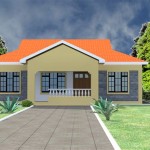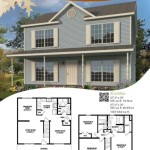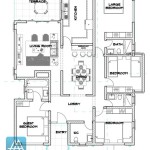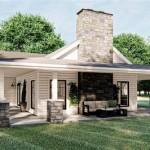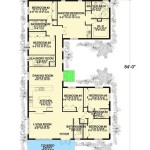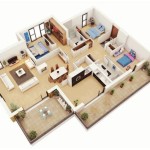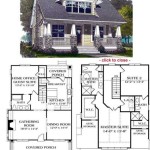Home Plans with In-Law Suite: A Comprehensive Guide
The concept of multi-generational living is experiencing a resurgence, driven by factors ranging from economic considerations to cultural shifts emphasizing family closeness. As a result, home plans with in-law suites are becoming increasingly popular. These designs offer a practical solution for families looking to accommodate aging parents, adult children returning home, or other relatives while maintaining a degree of privacy and independence for all parties involved.
An in-law suite, also sometimes referred to as a granny flat, accessory dwelling unit (ADU), or secondary suite, is a self-contained living space within or attached to a primary residence. It typically includes a bedroom, bathroom, living area, and kitchen or kitchenette. The design and features of an in-law suite can vary widely depending on the needs of the occupants, the layout of the main house, and local building codes and zoning regulations.
Choosing a home plan with an in-law suite requires careful consideration of several factors. This includes assessing the space requirements, determining the level of integration with the main house, complying with relevant regulations, and adhering to a realistic budget. This article will explore the key considerations and benefits associated with home plans featuring in-law suites, providing a comprehensive guide for prospective homeowners.
Understanding the Benefits of In-Law Suites
The advantages of incorporating an in-law suite into a home design are numerous and extend beyond simply providing additional living space. One of the primary benefits is the opportunity for multi-generational living. This arrangement allows families to share resources, provide care for elderly relatives or young children, and strengthen family bonds. Grandparents can actively participate in the lives of their grandchildren, and parents can receive support with childcare or household tasks.
Moreover, an in-law suite can offer significant financial advantages. For families caring for aging parents, the cost of building an in-law suite may be less than the expense of assisted living or nursing home care. Adult children returning home can contribute to household expenses, helping to alleviate financial burdens. In some cases, the in-law suite can be rented out to tenants, providing a source of rental income. It's crucial to research local regulations regarding renting out ADUs, as restrictions may apply.
Beyond the practical and financial benefits, an in-law suite can enhance the overall value and marketability of a home. As multi-generational living becomes increasingly common, properties with in-law suites are likely to attract a wider range of potential buyers. The flexibility of the space also appeals to buyers who may need accommodations for caregivers, guests, or home-based businesses.
Key Design Considerations for In-Law Suites
Designing an effective in-law suite requires careful planning to ensure the space meets the needs of its occupants while integrating seamlessly with the main house. The location of the suite within the overall floor plan is a critical consideration. Some common options include attaching the suite to the main house with a separate entrance, creating a separate living space above a garage or basement, or building a detached accessory dwelling unit on the property.
Accessibility is a paramount concern, particularly if the in-law suite is intended for elderly or disabled individuals. Features such as wider doorways, ramps or elevators, grab bars in bathrooms, and roll-in showers can greatly enhance the usability and safety of the space. Universal design principles should be incorporated to ensure the suite is adaptable to the changing needs of its occupants over time.
The level of integration with the main house is another important factor to consider. Some families prefer a completely separate living space with its own entrance, kitchen, and laundry facilities to maximize privacy and independence. Others may opt for a more integrated design, sharing certain common areas such as the kitchen or laundry room. The decision will depend on the preferences of the occupants and the overall design goals.
Energy efficiency is also a key design consideration. Incorporating energy-efficient windows, insulation, and appliances can help reduce utility costs and minimize the environmental impact of the in-law suite. Solar panels and other renewable energy sources can further enhance the sustainability of the design.
Navigating Legal and Regulatory Requirements
Before embarking on a home construction or renovation project involving an in-law suite, it is essential to research and comply with all applicable legal and regulatory requirements. Zoning regulations, building codes, and homeowner association rules can all impact the feasibility and design of an in-law suite.
Zoning regulations typically specify the permissible uses of a property, including whether accessory dwelling units are allowed. Some jurisdictions may have restrictions on the size, location, and density of ADUs. It is crucial to consult with local planning officials to determine the specific zoning requirements applicable to the property.
Building codes govern the construction and safety of buildings, including requirements for structural integrity, fire safety, and accessibility. In-law suites must comply with all relevant building codes to ensure the safety of the occupants and the structural integrity of the building. Obtaining the necessary building permits is essential before commencing construction.
Homeowner association (HOA) rules may also restrict the construction of in-law suites or impose specific design requirements. It is important to review the HOA covenants and restrictions to ensure compliance before investing in a home plan with an in-law suite. Failure to comply with HOA rules can result in fines or legal action.
In addition to zoning regulations, building codes, and HOA rules, there may be other regulatory requirements that apply to in-law suites, such as requirements for separate utility meters, parking spaces, or rental licenses. It is advisable to consult with a local attorney or real estate professional to ensure compliance with all applicable laws and regulations.
Finally, property tax implications should be considered. Adding an in-law suite generally increases the assessed value of the property, which may result in higher property taxes. It is important to understand the potential tax implications before proceeding with the project.
The cost of constructing an in-law suite can vary widely depending on the size, design, and features of the suite, as well as the location of the property and the cost of labor and materials. Remodeling an existing space, such as a basement or garage, is typically less expensive than building a new addition. However, even remodeling can involve significant costs, particularly if it requires structural modifications or the installation of plumbing and electrical systems.
New construction of an in-law suite can range from relatively modest to quite substantial, depending on the level of luxury and customization. The choice of materials, finishes, and appliances will also impact the overall cost. Obtaining multiple bids from qualified contractors is essential to ensure a competitive price and to avoid cost overruns.
Financing options for in-law suite construction may include home equity loans, construction loans, or government-sponsored programs. Home equity loans allow homeowners to borrow against the equity in their homes, while construction loans are specifically designed to finance home improvement projects. Government programs may offer grants or low-interest loans to homeowners who are building accessible housing for elderly or disabled individuals.
Planning ahead and creating a detailed budget are essential to successfully completing an in-law suite project. It is important to factor in not only the cost of construction but also the cost of permits, inspections, and design services. Contingency funds should also be included to cover unexpected expenses.
The selection of a suitable home plan with an in-law suite is a critical step in the process. There are numerous resources available to assist homeowners in finding the right plan, including online plan providers, architects, and builders. Online plan providers offer a wide selection of pre-designed home plans with in-law suites, which can be customized to meet specific needs and preferences. Architects can create custom home plans tailored to the unique requirements of the property and the homeowner.
Builders can provide valuable insights into the feasibility and cost of different home plans. They can also assist with obtaining the necessary permits and inspections. Choosing a builder with experience in constructing in-law suites is essential to ensure a successful project.
When selecting a home plan, it is important to consider the overall layout of the house, the existing features of the property, and the specific needs of the occupants. The plan should be designed to maximize the use of space, provide adequate privacy, and ensure accessibility for all residents. The plan should also comply with all applicable building codes and zoning regulations.
In conclusion, home plans with in-law suites offer a versatile solution for families seeking to accommodate multi-generational living arrangements or provide separate living spaces for relatives, caregivers, or tenants. Careful planning, attention to detail, and compliance with legal and regulatory requirements are essential to ensure a successful project. By understanding the key considerations and benefits associated with in-law suites, homeowners can make informed decisions and create a comfortable and functional living space that meets their specific needs.

Southern Style House Plan With In Law Suite

House Plan 65862 Tuscan Style With 2091 Sq Ft 3 Bed 2 Bath 1

In Law Suite Plans Give Mom Space And Keep Yours The House Designers

Front Side View House Plans With A Separate In Law Suite

House Plans With In Law Suites Houseplans Blog Com

House Plans With In Law Suites Houseplans Blog Com

Modern Farmhouse Plan With In Law Suite 70607mk Architectural Designs House Plans

Exquisite Mountain Modern Home Plan With In Law Suite And 4 Car Garage 95104rw Architectural Designs House Plans

Adding An In Law Suite Designing Your Perfect House

Homes With Mother In Law Suites
Related Posts

